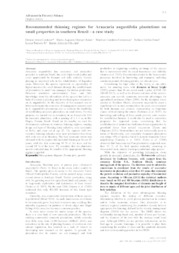Recommended thinning regimes for Araucaria angustifolia plantations on small properties in southern Brazil: a case study.
Recommended thinning regimes for Araucaria angustifolia plantations on small properties in southern Brazil: a case study.
Author(s): CARDOSO, D. J.; ROSOT, M. A. D.; GARRASTAZU, M. C.; ROSOT, N. C.; TONIOLO JÚNIOR, L.; OLIVEIRA, K. A. de
Summary: Araucaria angustifolia has economic and productive potential in southern Brazil, due to its high wood quality and seeds appreciated by humans and wild animals, besides playing an important role in the rehabilitation of degraded areas. Moreover, the species represents an opportunity of higher incomes for small farmers through the establishment of plantations in small lots managed for timber production. However restrictive environmental laws, and little knowledge about the silviculture of the species has led to a lack of interest in planting and in developing new researches on A. angustifolia. So the objective of this research was to better understand the outcomes of management systems used in A. angustifolia plantations and to evaluate the feasibility of establishing araucaria plantations on small farms. For this purpose, we carried out an inventory in an 8-year-old, 0.92 ha araucaria plantation, with a spacing of 3 x 3 m, in Rio Negro, Paraná, Brazil. Based on the results, we used the SisAraucaria software to simulate thinning regimes, varying in age and type of thinning (only selective, only systematic or both), and clear cut at age 25. The regimes with two selective thinning episodes were more productive than those with only one or no thinning. The best economic return was obtained with the regime that included thinning at 10 and 20 years, with the first removing 80 % of the trees and the second 20 % of the trees. We conclude that the plantation model evaluated may be feasible if the appropriate thinning regime is applied.
Publication year: 2017
Types of publication: Journal article
Unit: Embrapa Forestry
Observation
Some of Embrapa's publications are published as ePub files. To read them, use or download one of the following free software options to your computer or mobile device. Android: Google Play Books; IOS: iBooks; Windows and Linux: Calibre.
Access other publications
Access the Agricultural Research Database (BDPA) to consult Embrapa's full library collection and records.
Visit Embrapa Bookstore to purchase books and other publications sold by Embrapa.

